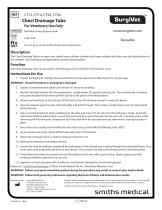 Website:
Smiths Medical Surgivet
Website:
Smiths Medical Surgivet
Group: Smiths Group
Catalog excerpts

Chest Drainage Tube For Veterinary Use Only Sterilized using ethylene oxide Latex Free For use by or on the order of a licensed veterinarian. Description The Chest Drainage Tube is an open-end, single lumen silicone catheter with large multiple side holes over the distal portion of the catheter. See individual package label for product specifications. Function The Chest Drainage Tube can be used for the drainage of air or fluid from the thoracic cavity. Instructions for Use 1. Inspect packaging for sterility. Remove product from package and visually inspect for any damage. WARNING! Discard if product or packaging is damaged. 2. Sedate or anesthetize the patient and restrain in lateral recumbency. 3. Identify the landmarks for the skin preparation: caudal border of scapula to the last rib. The insertion site is midway along the line drawn from the top of the last rib to the point of the flexed elbow. 4. Infuse local anesthetic at this site just off the front of the rib and deep enough to reach the pleura. 5. Have an assistant grasp the skin of the shoulder and pull it forward. Then make a small incision over the denervated intercostal site. 6. Use a curved hemostat to make a pathway for the tube and leave it in the site once the pathway is made. Grasp the tube at the distal tip with another curved hemostat and then insert the tube into the site with a rotating action while removing the first hemostat. Release the tip of the tube from the second hemostat and remove, leaving the tube in place. 7. Direct the tube cranially and ventrally into the chest using a stylet (Metal Stiffening Stylet, MSS). 8. As you remove the stylet, clamp off the tube with a pair of hemostats. 9. Attach the drainage tube to a multi-functional connection set. 10. Remove the hemostat and release the skin. 11. Anchor the tube by walking a needle off the periosteum of the rib and pass a suture through the intercostal fascia. Tie a loose stitch with a tight knot off three or four throws. Then anchor the tube to the thread with an anchoring stitch. 12. Check that air has been evacuated and seal the catheter at the skin with a purse string. Apply a gauze pad with antibiotic ointment (optional) over the site. 13. Apply an occlusive dressing with an adhesive cranial band, leaving the suction end exposed. Reference: Critical Care Techniques, CD Rom, Smiths Medical PM, Inc., Waukesha, Wisconsin, USA. WARNING! Failure to properly immobilize patient during the procedure may result in serious injury and/or death. WARNING! Follow local governing ordinances regarding disposal of sharps and biohazardous wastes. Manufactured By: Smiths Medical PM, Inc. N7W22025 Johnson Drive Waukesha, Wisconsin 53186 Phone: 1-262-513-8500 Toll-Free: 1-888-745-6562 (U.S.A. only) Fax: 1-262-513-9069 SurgiVet and the Smiths design mark are trademarks of the Smiths Medical family of companies. The symbol ® indicates the trademark is registered in the U.S. Patent and Trademark Office and certain other countries. ©2009 Smiths Medical Family of companies. All rights reserved.
Open the catalog to page 1All Smiths Medical Surgivet catalogs and technical brochures
-
Animal Consumables
2 Pages
-
Veterinary Equipment and Disposables
100 Pages
-
V3395 TPR Monitor
2 Pages
-
Classic T3 Vaporizer
2 Pages
-
SurgiVet® V9004
2 Pages
-
SurgiVet® V8401
2 Pages
-
Advisor® Vital Signs Monitor
2 Pages
-
Equipment Catalog
50 Pages
-
Ear Lavage Catheter
1 Pages
-
Heimlich One-Way Valve
1 Pages
-
Thoracic Drainage Catheter
1 Pages
-
Foal Tracheal
1 Pages
-
Equator Sales Brochure
2 Pages
-
Consumables Catalog
38 Pages
Archived catalogs
-
Equipment Catalog - 2012
50 Pages


























